Genome-Wide Identification and Characterization of Tomato Fatty Acid β-Oxidase Family Genes KAT and MFP
Abstract
1. Introduction
2. Results
2.1. Genome-Wide Identification of SlKAT and SlMFP Genes in Tomatoes
2.2. Analysis of Conserved Motifs and Gene Structure of the SlKAT and SlMFP Family Genes in Tomatoes
2.3. Phylogenetic Analysis of KAT and MFP Family Members
2.4. Protein Secondary Structure Analysis and Subcellular Localization of Tomato KAT and MFP Family Members
2.5. Chromosomal Localization of SlKAT and SlMFP Genes in Tomatoes
2.6. Analysis of Cis-Acting Elements of the Tomato SlKAT and SlMFP Family Genes
2.7. Tissue Expression Analysis of Tomato SlKAT and SlMFP Family Genes
2.8. Gene Duplication and Collinearity Analysis of the SlKAT and SlMFP Genes
2.9. Evolutionary Selection Pressure Analysis of SlKAT and SlMFP Genes
2.10. Expression Profile Analysis of the SlKAT and SlMFP Genes in Response to Hormone and Abiotic Stresses
3. Discussion
4. Materials and Methods
4.1. Genome-Wide Identification of MFP and KAT Gene Family Members in Tomatoes
4.2. Gene Structure and Chromosomal Localization
4.3. Gene Structure and Protein Conserved Domain Analysis
4.4. Phylogenetic Analysis
4.5. Cis-Acting Element Analysis of the Tomato SlKAT and SlMFP Genes
4.6. Characterization of SlKAT and SlMFP Genes in Tomatoes
4.7. Analysis of Tissue Expression of SlKAT and SlMFP Genes in Tomatoes
4.8. Ka (Nonsynonymous)/Ks (Synonymous) Analysis and Colinearity Analysis
4.9. Plant Materials, Growth Conditions, and Stress Treatments
4.10. RNA Isolation and qRT-PCR
5. Conclusions
Supplementary Materials
Author Contributions
Funding
Institutional Review Board Statement
Informed Consent Statement
Data Availability Statement
Conflicts of Interest
References
- Pan, R.; Liu, J.; Hu, J. Peroxisomes in plant reproduction and seed-related development. J. Integr. Plant Biol. 2019, 61, 784–802. [Google Scholar] [CrossRef]
- Charlton, W.L.; Johnson, B.; Graham, I.A.; Baker, A. Non-coordinate expression of peroxisome biogenesis, β-oxidation and glyoxylate cycle genes in mature Arabidopsis plants. Plant Cell Rep. 2004, 23, 647–653. [Google Scholar] [CrossRef] [PubMed]
- Cassin-Ross, G.; Hu, J. Systematic Phenotypic Screen of Arabidopsis Peroxisomal Mutants Identifies Proteins Involved in β-Oxidation. Plant Physiol. 2014, 166, 1546–1559. [Google Scholar] [CrossRef]
- Kaur, N.; Reumann, S.; Hu, J. Peroxisome Biogenesis and Function. Arab. Book 2009, 7, e0123. [Google Scholar] [CrossRef] [PubMed][Green Version]
- Eastmond, P.J.; Hooks, M.; Graham, I.A. The Arabidopsis acyl-CoA oxidase gene family. Biochem. Soc. Trans. 2000, 28, 755–757. [Google Scholar] [CrossRef]
- Wasternack, C.; Parthier, B. Jasmonate-signalled plant gene expression. Trends Plant Sci. 1997, 2, 302–307. [Google Scholar] [CrossRef]
- Holtman, W.L.; Heistek, J.C.; Mattern, K.A.; Bakhuizen, R.; Douma, A.C. β-oxidation of fatty acids is linked to the glyoxylate cycle in the aleurone but not in the embryo of germinating barley. Plant Sci. 1994, 99, 43–53. [Google Scholar] [CrossRef]
- Fosså, A.; Beyer, A.; Pfitzner, E.; Wenzel, B.; Kunau, W.H. Molecular cloning, sequencing and sequence analysis of the fox-2 gene of Neurospora crassa encoding the multifunctional β-oxidation protein. Mol. Gen. Genet. 1995, 247, 95–104. [Google Scholar] [CrossRef] [PubMed]
- Castillo, M.C.; Martínez, C.; Buchala, A.; Métraux, J.-P.; León, J. Gene-Specific Involvement of β-Oxidation in Wound-Activated Responses in Arabidopsis. Plant Physiol. 2004, 135, 85–94. [Google Scholar] [CrossRef]
- Eastmond, P.J.; Graham, I.A. The multifunctional protein At MFP2 is co-ordinately expressed with other genes of fatty acid β-oxidation during seed germination in Arabidopsis thaliana (L.) Heynh. Biochem. Soc. Trans. 2000, 28, 95–99. [Google Scholar] [CrossRef]
- Chu, C.; Mao, L.F.; Schulz, H. Estimation of peroxisomal β-oxidation in rat heart by a direct assay of acyl-CoA oxidase. Biochem. J. 1994, 302, 23–29. [Google Scholar] [CrossRef]
- Pinfield-Wells, H.; Rylott, E.L.; Gilday, A.D.; Graham, S.; Job, K.; Larson, T.R.; Graham, I.A. Sucrose rescues seedling establishment but not germination of Arabidopsis mutants disrupted in peroxisomal fatty acid catabolism. Plant J. 2005, 43, 861–872. [Google Scholar] [CrossRef] [PubMed]
- Rylott, E.L.; Rogers, C.A.; Gilday, A.D.; Edgell, T.; Larson, T.R.; Graham, I.A. Arabidopsis Mutants in Short- and Medium-chain Acyl-CoA Oxidase Activities Accumulate Acyl-CoAs and Reveal That Fatty Acid β-Oxidation Is Essential for Embryo Development. J. Biol. Chem. 2003, 278, 21370–21377. [Google Scholar] [CrossRef] [PubMed]
- Arent, S.; Christensen, C.E.; Pye, V.E.; Nørgaard, A.; Henriksen, A. The Multifunctional Protein in Peroxisomal β-Oxidation. J. Biol. Chem. 2010, 285, 24066–24077. [Google Scholar] [CrossRef] [PubMed]
- Richmond, T.A.; Bleecker, A.B. A Defect in β-Oxidation Causes Abnormal Inflorescence Development in Arabidopsis. Plant Cell 1999, 11, 1911–1923. [Google Scholar] [PubMed]
- Afitlhile, M.M.; Fukushige, H.; Nishimura, M.; Hildebrand, D.F. A defect in glyoxysomal fatty acid β-oxidation reduces jasmonic acid accumulation in Arabidopsis. Plant Physiol. Biochem. 2005, 43, 603–609. [Google Scholar] [CrossRef] [PubMed]
- Wang, Z.-Y.; Soanes, D.M.; Kershaw, M.J.; Talbot, N.J. Functional Analysis of Lipid Metabolism in Magnaporthe grisea Reveals a Requirement for Peroxisomal Fatty Acid β-Oxidation During Appressorium-Mediated Plant Infection. Mol. Plant-Microbe Interact. 2007, 20, 475–491. [Google Scholar] [CrossRef] [PubMed]
- Wiszniewski, A.A.G.; Smith, S.M.; Bussell, J.D. Conservation of two lineages of peroxisomal (Type I) 3-ketoacyl-CoA thiolases in land plants, specialization of the genes in Brassicaceae, and characterization of their expression in Arabidopsis thaliana. J. Exp. Bot. 2012, 63, 6093–6103. [Google Scholar] [CrossRef] [PubMed]
- Castillo, M.C.; León, J. Expression of the β-oxidation gene 3-ketoacyl-CoA thiolase 2 (KAT2) is required for the timely onset of natural and dark-induced leaf senescence in Arabidopsis. J. Exp. Bot. 2008, 59, 2171–2179. [Google Scholar] [CrossRef]
- Theodoulou, F.L.; Job, K.; Slocombe, S.P.; Footitt, S.; Holdsworth, M.; Baker, A.; Larson, T.R.; Graham, I.A. Jasmonic Acid Levels Are Reduced in COMATOSE ATP-Binding Cassette Transporter Mutants. Implications for Transport of Jasmonate Precursors into Peroxisomes. Plant Physiol. 2005, 137, 835–840. [Google Scholar] [CrossRef]
- Xing, Y.; Lee, C. Assessing the application of Ka/Ks ratio test to alternatively spliced exons. Bioinformatics 2005, 21, 3701–3703. [Google Scholar] [CrossRef] [PubMed]
- Guo, L.; Lu, S.; Liu, T.; Nai, G.; Ren, J.; Gou, H.; Chen, B.; Mao, J. Genome-Wide Identification and Abiotic Stress Response Analysis of PP2C Gene Family in Woodland and Pineapple Strawberries. Int. J. Mol. Sci. 2023, 24, 4049. [Google Scholar] [CrossRef] [PubMed]
- Moerkercke, A.V.; Schauvinhold, I.; Pichersky, E.; Haring, M.A.; Schuurink, R.C. A plant thiolase involved in benzoic acid biosynthesis and volatile benzenoid production. Plant J. 2009, 60, 292–302. [Google Scholar] [CrossRef]
- Rylott, E.L.; Eastmond, P.J.; Gilday, A.D.; Slocombe, S.P.; Larson, T.R.; Baker, A.; Graham, I.A. The Arabidopsis thaliana multifunctional protein gene (MFP2) of peroxisomal β-oxidation is essential for seedling establishment. Plant J. 2006, 45, 930–941. [Google Scholar] [CrossRef] [PubMed]
- Gao, R.; Luo, Y.; Pan, X.; Wang, C.; Liao, W. Genome-wide identification of SHMT family genes in cucumber (Cucumis sativus L.) and functional analyses of CsSHMTs in response to hormones and abiotic stresses. 3 Biotech 2022, 12, 305. [Google Scholar] [CrossRef] [PubMed]
- Pan, X.; Wang, C.; Liu, Z.; Gao, R.; Feng, L.; Li, A.; Yao, K.; Liao, W. Identification of ABF/AREB gene family in tomato (Solanum lycopersicum L.) and functional analysis of ABF/AREB in response to ABA and abiotic stresses. PeerJ 2023, 11, e15310. [Google Scholar] [CrossRef]
- Liu, Z.; Pan, X.; Wang, C.; Yun, F.; Huang, D.; Yao, Y.; Gao, R.; Ye, F.; Liu, X.; Liao, W. Genome-wide identification and expression analysis of serine hydroxymethyltransferase (SHMT) gene family in tomato (Solanum lycopersicum). PeerJ 2022, 10, e12943. [Google Scholar] [CrossRef]
- Woese, C.R. Interpreting the universal phylogenetic tree. Proc. Natl. Acad. Sci. USA 2000, 97, 8392–8396. [Google Scholar] [CrossRef]
- Ptitsyn, O.B.; Finkelstein, A.V. Theory of protein secondary structure and algorithm of its prediction. Biopolymers 2004, 22, 15–25. [Google Scholar] [CrossRef]
- Srinivasan, R.; Rose, G.D. A physical basis for protein secondary structure. Proc. Natl. Acad. Sci. USA 1999, 96, 14258–14263. [Google Scholar] [CrossRef] [PubMed]
- Fenn, M.A.; Giovannoni, J.J. Phytohormones in fruit development and maturation. Plant J. 2021, 105, 446–458. [Google Scholar] [CrossRef]
- Kou, X.; Zhou, J.; Wu, C.E.; Yang, S.; Liu, Y.; Chai, L.; Xue, Z. The interplay between ABA/ethylene and NAC TFs in tomato fruit ripening: A review. Plant Mol. Biol. 2021, 106, 223–238. [Google Scholar] [CrossRef] [PubMed]
- Jiang, T.; Zhang, X.-F.; Wang, X.-F.; Zhang, D.-P. Arabidopsis 3-Ketoacyl-CoA Thiolase-2 (KAT2), an Enzyme of Fatty Acid β-Oxidation, is Involved in ABA Signal Transduction. Plant Cell Physiol. 2011, 52, 528–538. [Google Scholar] [CrossRef] [PubMed]
- Pietrocola, F.; Galluzzi, L.; Bravo-San Pedro, J.M.; Madeo, F.; Kroemer, G. Acetyl Coenzyme A: A Central Metabolite and Second Messenger. Cell Metab. 2015, 21, 805–821. [Google Scholar] [CrossRef] [PubMed]
- Yu, M.; Shen, L.; Fan, B.; Zhao, D.; Zheng, Y.; Sheng, J. The effect of MeJA on ethylene biosynthesis and induced disease resistance to Botrytis cinerea in tomato. Postharvest Biol. Technol. 2009, 54, 153–158. [Google Scholar] [CrossRef]
- de Wit, M.; Galvão, V.C.; Fankhauser, C. Light-Mediated Hormonal Regulation of Plant Growth and Development. Annu. Rev. Plant Biol. 2016, 67, 513–537. [Google Scholar] [CrossRef] [PubMed]
- Yu, L.; Fan, J.; Xu, C. Peroxisomal fatty acid β-oxidation negatively impacts plant survival under salt stress. Plant Signal. Behav. 2019, 14, 1561121. [Google Scholar] [CrossRef] [PubMed]
- Jouyban, Z. The effects of salt stress on plant growth. Tech. J. Eng. Appl. Sci. 2012, 2, 7–10. [Google Scholar]
- Farooq, M.; Hussain, M.; Wahid, A.; Siddique, K.H.M. Drought Stress in Plants: An Overview. In Plant Responses to Drought Stress: From Morphological to Molecular Features; Aroca, R., Ed.; Springer: Berlin/Heidelberg, Germany, 2012; pp. 1–33. [Google Scholar]
- Adams, S. Effect of Temperature on the Growth and Development of Tomato Fruits. Ann. Bot. 2001, 88, 869–877. [Google Scholar] [CrossRef]
- del Río, L.A.; López-Huertas, E. ROS Generation in Peroxisomes and its Role in Cell Signaling. Plant Cell Physiol. 2016, 57, 1364–1376. [Google Scholar] [CrossRef]
- Le, T.-N.; Schumann, U.; Smith, N.A.; Tiwari, S.; Au, P.C.K.; Zhu, Q.-H.; Taylor, J.M.; Kazan, K.; Llewellyn, D.J.; Zhang, R.; et al. DNA demethylases target promoter transposable elements to positively regulate stress responsive genes in Arabidopsis. Genome Biol. 2014, 15, 458. [Google Scholar] [CrossRef]
- Wang, L.; Wang, C.; Liu, X.; Cheng, J.; Li, S.; Zhu, J.-K.; Gong, Z. Peroxisomal β-oxidation regulates histone acetylation and DNA methylation in Arabidopsis. Proc. Natl. Acad. Sci. USA 2019, 116, 10576–10585. [Google Scholar] [CrossRef] [PubMed]
- Goodstein, D.M.; Shu, S.; Howson, R.; Neupane, R.; Hayes, R.D.; Fazo, J.; Mitros, T.; Dirks, W.; Hellsten, U.; Putnam, N.; et al. Phytozome: A comparative platform for green plant genomics. Nucleic Acids Res. 2012, 40, D1178–D1186. [Google Scholar] [CrossRef]
- Yao, K.; Yao, Y.; Ding, Z.; Pan, X.; Zheng, Y.; Huang, Y.; Zhang, Z.; Li, A.; Wang, C.; Li, C.; et al. Characterization of the FLA Gene Family in Tomato (Solanum lycopersicum L.) and the Expression Analysis of SlFLAs in Response to Hormone and Abiotic Stresses. Int. J. Mol. Sci. 2023, 24, 16063. [Google Scholar] [CrossRef] [PubMed]
- Li, Z.; Shen, J.; Liang, J. Genome-Wide Identification, Expression Profile, and Alternative Splicing Analysis of the Brassinosteroid-Signaling Kinase (BSK) Family Genes in Arabidopsis. Int. J. Mol. Sci. 2019, 20, 1138. [Google Scholar] [CrossRef] [PubMed]
- Chen, C.; Chen, H.; Zhang, Y.; Thomas, H.R.; Frank, M.H.; He, Y.; Xia, R. TBtools: An Integrative Toolkit Developed for Interactive Analyses of Big Biological Data. Mol. Plant 2020, 13, 1194–1202. [Google Scholar] [CrossRef] [PubMed]
- Chen, J.; Huang, X.Y.; Salt, D.E.; Zhao, F.J. Mutation in OsCADT1 enhances cadmium tolerance and enriches selenium in rice grain. New Phytol. 2020, 226, 838–850. [Google Scholar] [CrossRef]
- Liu, Y.; Wen, H.; Qi, X.; Zhang, X.; Zhang, K.; Fan, H.; Tian, Y.; Hu, Y.; Li, Y. Genome-wide identification of the Na+/H+ exchanger gene family in Lateolabrax maculatus and its involvement in salinity regulation. Comp. Biochem. Physiol. Part D Genom. Proteom. 2019, 29, 286–298. [Google Scholar] [CrossRef]
- Liu, K.; Yuan, C.; Li, H.; Lin, W.; Yang, Y.; Shen, C.; Zheng, X. Genome-wide identification and characterization of auxin response factor (ARF) family genes related to flower and fruit development in papaya (Carica papaya L.). BMC Genom. 2015, 16, 901. [Google Scholar] [CrossRef]
- Kumar, S.; Stecher, G.; Tamura, K. MEGA7: Molecular Evolutionary Genetics Analysis Version 7.0 for Bigger Datasets. Mol. Biol. Evol. 2016, 33, 1870–1874. [Google Scholar] [CrossRef]
- Song, Z.; Pan, F.; Lou, X.; Wang, D.; Yang, C.; Zhang, B.; Zhang, H. Genome-wide identification and characterization of Hsp70 gene family in Nicotiana tabacum. Mol. Biol. Rep. 2019, 46, 1941–1954. [Google Scholar] [CrossRef] [PubMed]
- Marti, E. Genetic and physiological characterization of tomato cv. Micro-Tom. J. Exp. Bot. 2006, 57, 2037–2047. [Google Scholar] [CrossRef] [PubMed]
- Schmittgen, T.D.; Livak, K.J. Analyzing real-time PCR data by the comparative C(T) method. Nat. Protoc. 2008, 3, 1101–1108. [Google Scholar] [CrossRef] [PubMed]
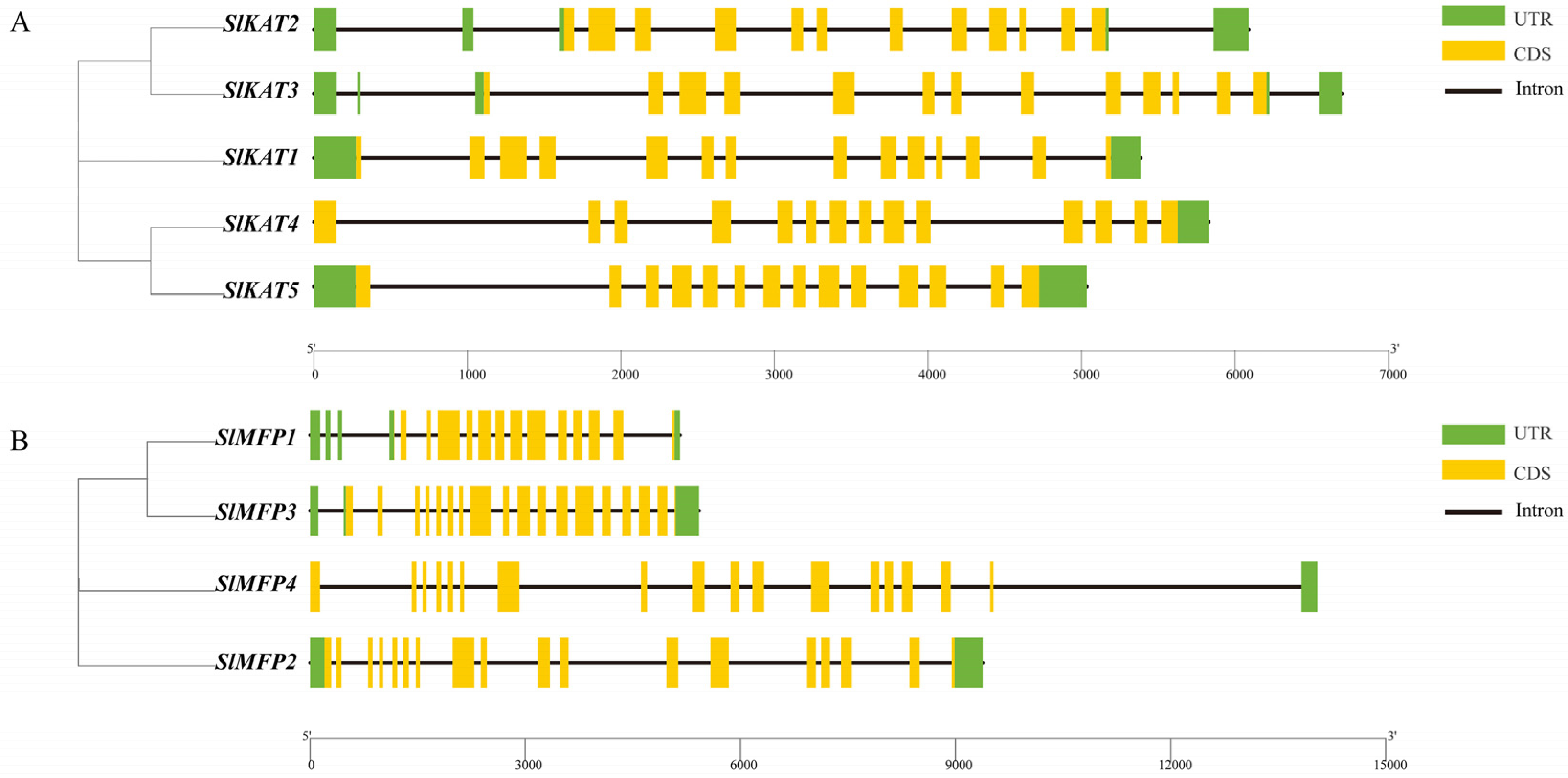
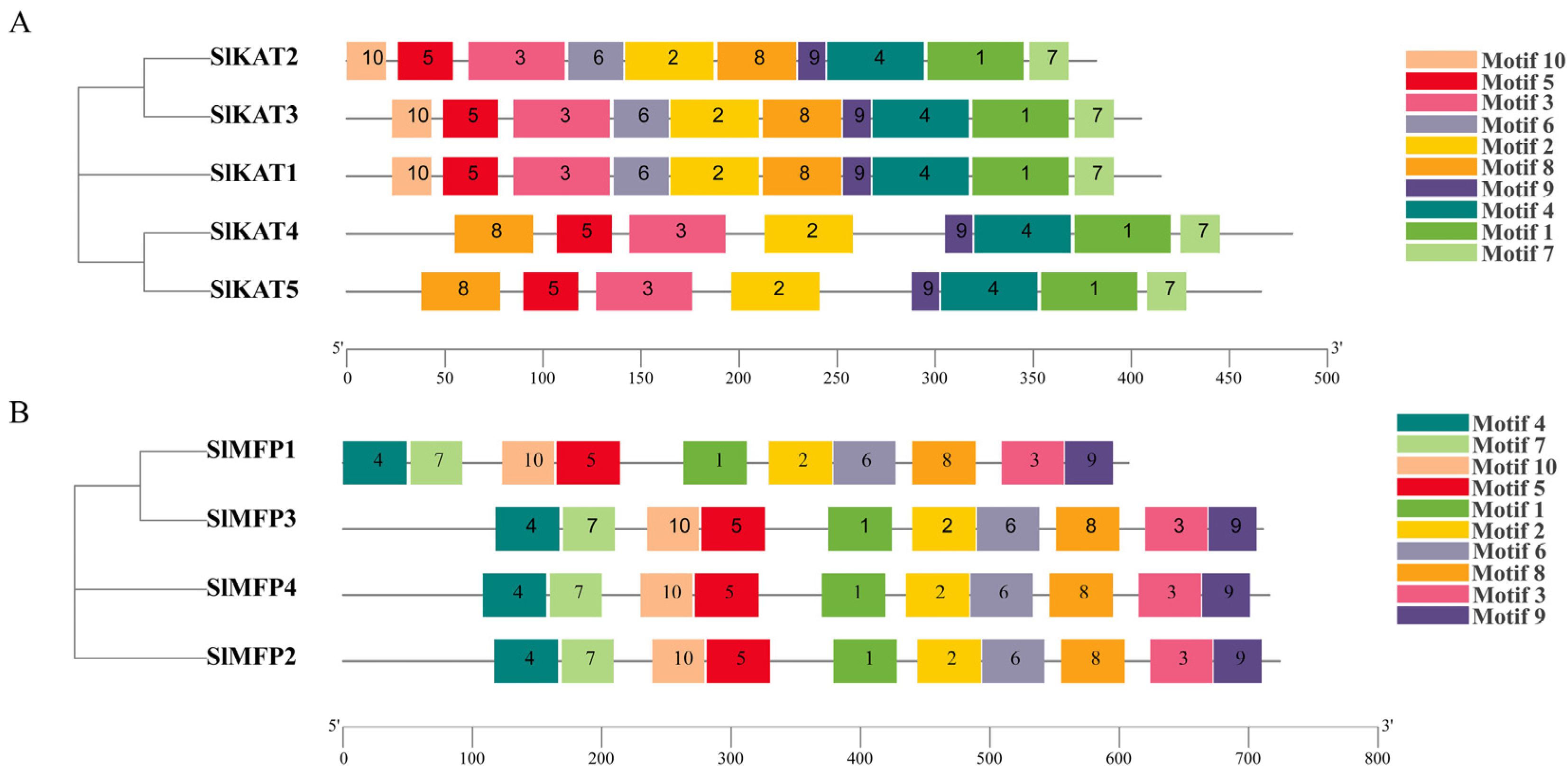

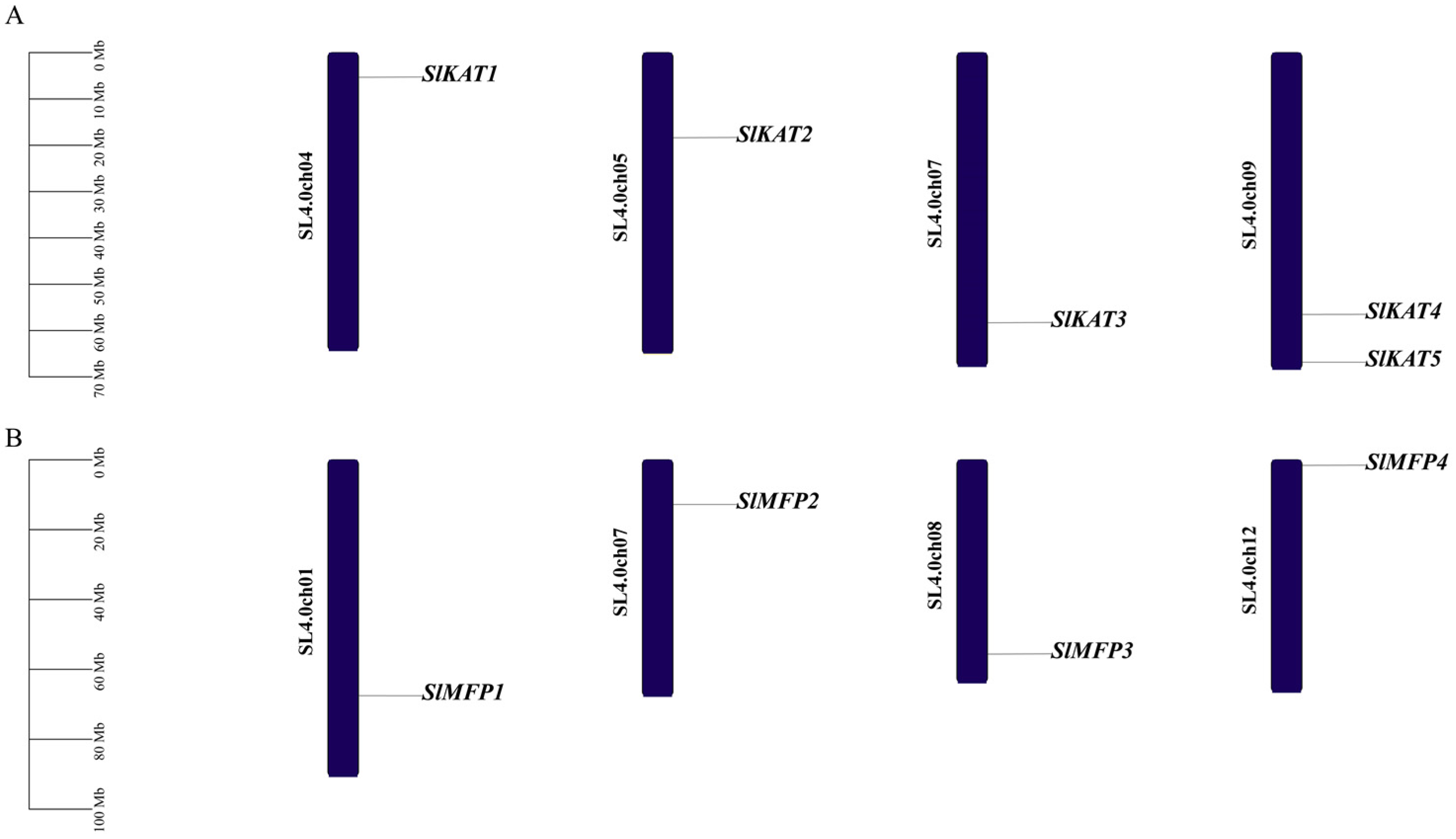

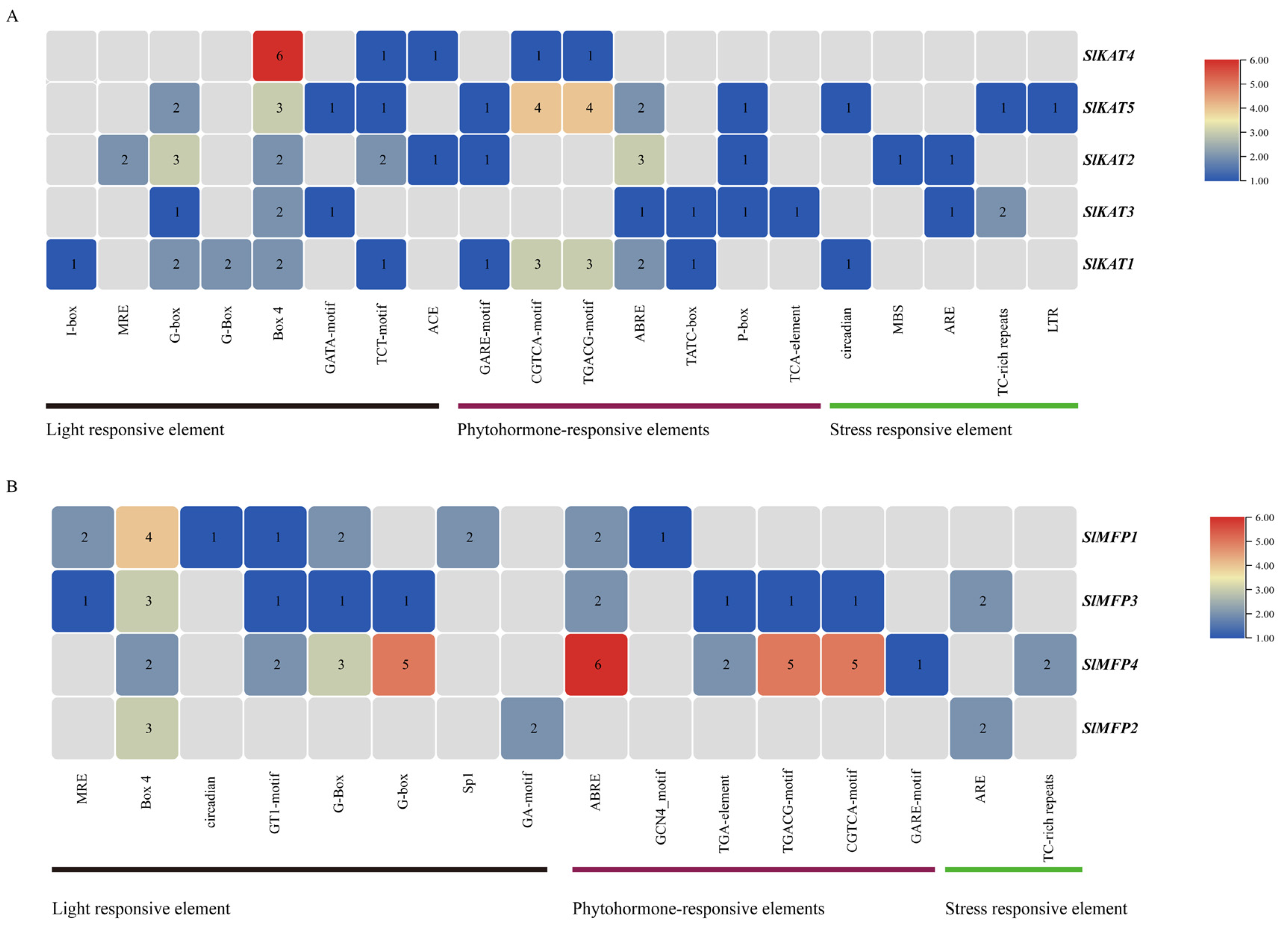
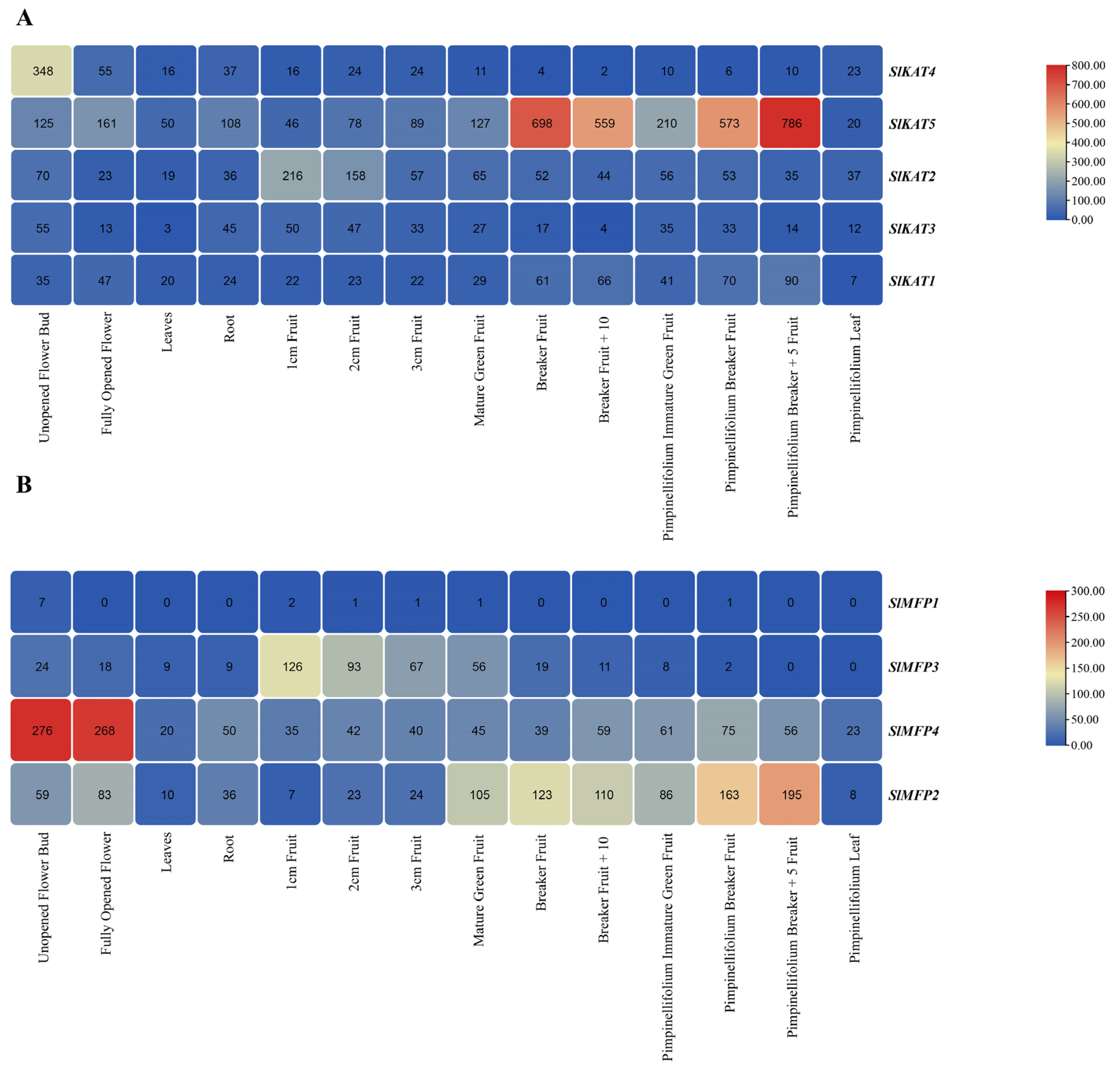
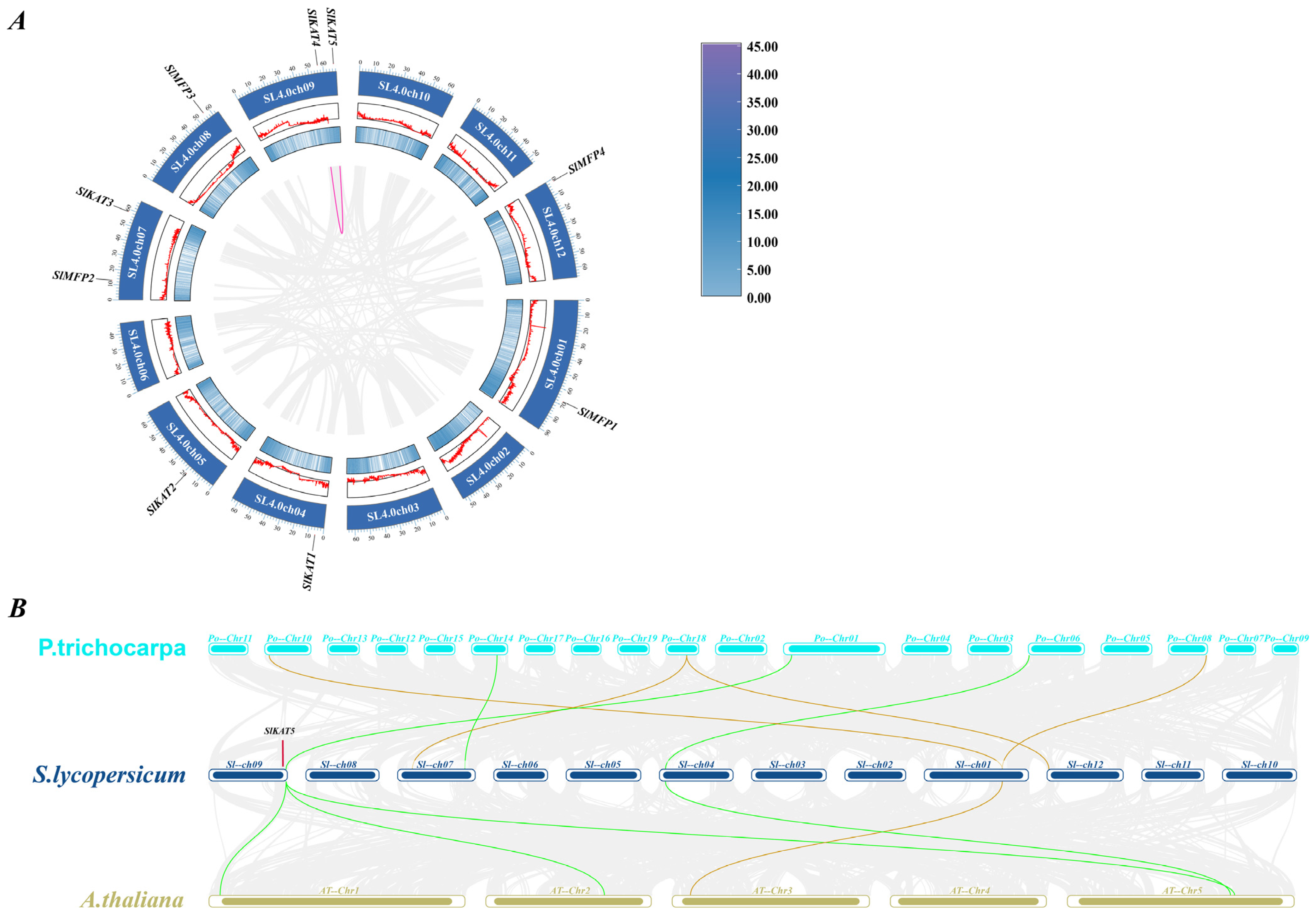


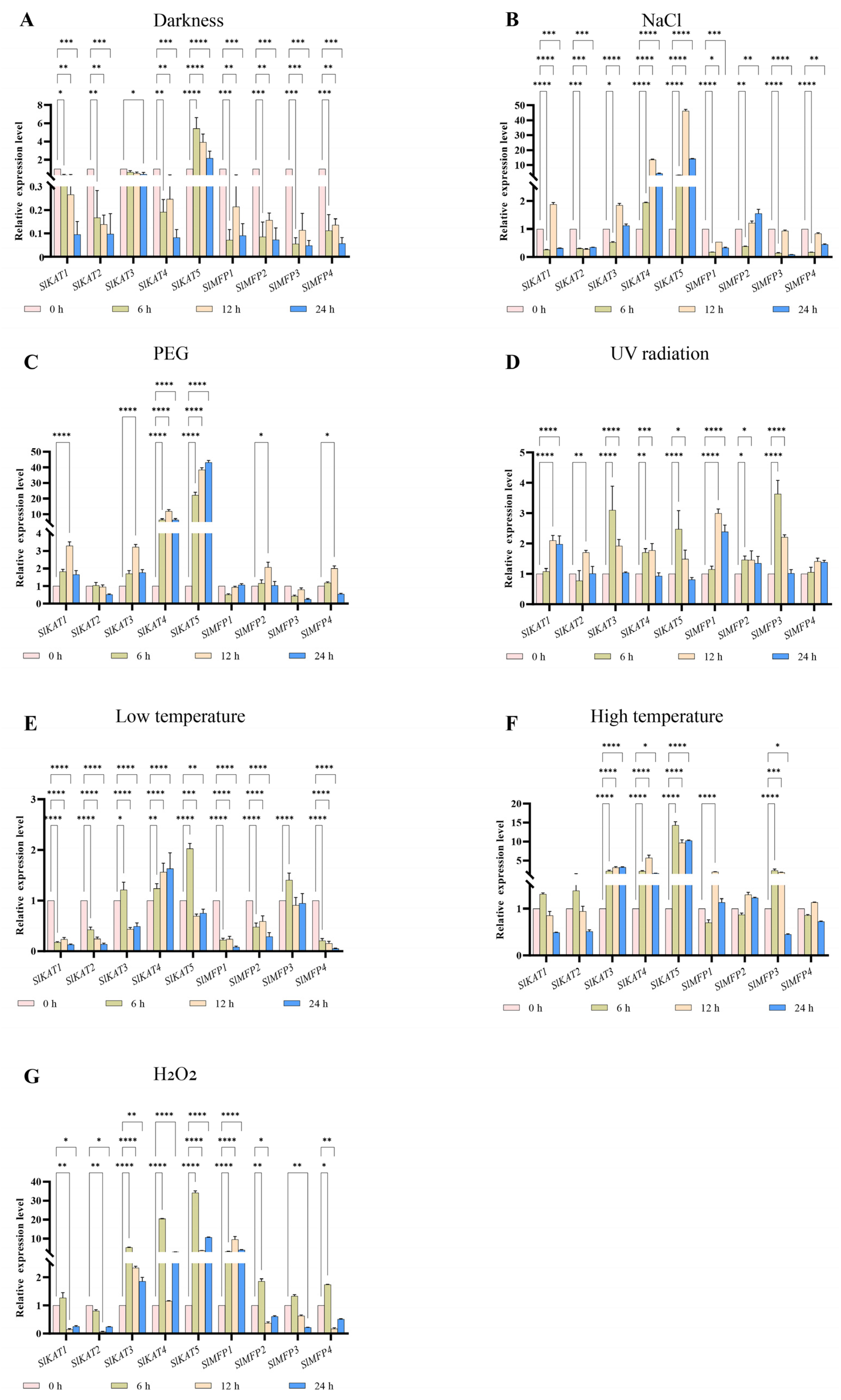
| Gene | Gene ID | Gene Locus | ORF (bp) | Amino Acid | Molecular Weight (Da) | pI | GRAVY |
|---|---|---|---|---|---|---|---|
| SlKAT1 | Solyc04g015100.3.1. ITAG4.0 | Chr04 | 1245 | 414 | 42,901.37 | 8.87 | 0.17 |
| SlKAT2 | Solyc05g017760.4.1. ITAG4.0 | Chr05 | 1146 | 381 | 39,128.82 | 5.73 | 0.12 |
| SlKAT3 | Solyc07g045350.4.1. ITAG4.0 | Chr07 | 1215 | 404 | 41,312.49 | 6.47 | 0.156 |
| SlKAT4 | Solyc09g061840.4.1. ITAG4.0 | Chr09 | 1446 | 481 | 50,588.34 | 8.67 | 0.116 |
| SlKAT5 | Solyc09g091470.3.1. ITAG4.0 | Chr09 | 1398 | 465 | 49,024.19 | 7.97 | −0.023 |
| SlMFP1 | Solyc01g066620.4.1. ITAG4.0 | Chr01 | 1821 | 606 | 67,336.01 | 9.04 | 0.043 |
| SlMFP2 | Solyc07g019670.4.1. ITAG4.0 | Chr07 | 2172 | 723 | 78,397.7 | 9.33 | 0.092 |
| SlMFP3 | Solyc08g068390.3.1. ITAG4.0 | Chr08 | 2133 | 710 | 77,162.22 | 5.68 | 0.029 |
| SlMFP4 | Solyc12g007170.3.1. ITAG4.0 | Chr12 | 2148 | 715 | 77,793.88 | 9.11 | 0.108 |
| Motif | Width (aa) | Motif Sequence |
|---|---|---|
| Motif 1 | 50 | SQIDYYEINEAFAVVALANQKLLGLBPEKINVHGGAVSLGHPLGCSGARI |
| Motif 2 | 46 | GMGVCAENCAERFKITREEQDQYAVQSFERGIAAQESGAFAWEIVP |
| Motif 3 | 50 | PNTVICTTVNKVCSSGLKATMLAAQSIQAGFNDIVVAGGMESMSNVPKYL |
| Motif 4 | 50 | VLVSGEKAIKLGLPVIGKIRGFADAAQEPELFGIAPALAIPKAIKSAGLE |
| Motif 5 | 29 | KANVDPSLVEEVFFGNVLSANLGQAPARQ |
| Motif 6 | 29 | EARKGSRLGHDSLVDGMLKDGLTDVYNDC |
| Motif 7 | 21 | TLLGVLRQKDGKFGVAGVCNG |
| Motif 8 | 41 | EVSGGRGRPSVIVDKDEGLAKFDGAKLRKLRPSFKDTDGTV |
| Motif 9 | 15 | TAGNASQISDGAAAL |
| Motif 10 | 21 | MGGFLGSLSSLSATKLGSIAI |
| Motif | Width (aa) | Motif Sequence |
|---|---|---|
| Motif 1 | 50 | LDYEDFKDVDMVIEAVIENVPLKQQIFIDIEKVCPPHCILASNTSTIDLN |
| Motif 2 | 50 | HFFSPAHVMPLLEIVRTEKTSPQVILDLMAVGKAIKKVPVVVGNCTGFAV |
| Motif 3 | 49 | EMILFPVVNEACRVLDEGIVVRASDLDIASVLGMSFPSYRGGIVFWADT |
| Motif 4 | 50 | LGCHARIAAPRAQLGLPELSLGVIPGFGGTQRLPRLIGLSKAVDMMMTSK |
| Motif 5 | 50 | LVHIFFAQRATSKVPNVTDIGLKPRSIKKVAIIGGGLMGSGIATALILSN |
| Motif 6 | 49 | NRTFFPYSQGAQLLVNLGVDVYRIDTQITEFGLPMGPFQLQDLAGYGVA |
| Motif 7 | 41 | MSEEGKELGLIDAIVPSDELLKVARRWALDIAERRKPWMRA |
| Motif 8 | 50 | DRVFKSPLVDLLIKSGRNGKNNGKGYYIYDKGRKPRPDPSVLPIIEESRR |
| Motif 9 | 38 | VGAGHIYSSLKKWSEIYGNFFKPSKFLEEKAAKGIPLS |
| Motif 10 | 41 | NMPQHLACJDVIEEGIVHGGYNGJLKEAKVFEDLVLSDTSK |
| Protein | Alpha Helix (%) | Beta Turn (%) | Random Coil (%) | Distribution of Secondary Structure Elements |
|---|---|---|---|---|
| SlKAT1 | 45.65 | 8.94 | 31.64 |  |
| SlKAT2 | 49.61 | 9.45 | 26.77 |  |
| SlKAT3 | 46.04 | 8.91 | 30.20 |  |
| SlKAT4 | 39.71 | 8.11 | 36.17 |  |
| SlKAT5 | 44.52 | 7.53 | 32.69 |  |
| SlMFP1 | 52.31 | 5.28 | 33.83 |  |
| SlMFP2 | 50.21 | 7.75 | 31.67 |  |
| SlMFP3 | 50.00 | 7.04 | 32.82 |  |
| SlMFP4 | 49.37 | 6.99 | 33.85 |  |
| Protein | Nucleus | Chloroplast | Cytosol | Peroxisome | Plasma Membrane | Endoplasmic Reticulum |
|---|---|---|---|---|---|---|
| SlKAT4 | — | 4 | 4 | 1 | — | — |
| SlKAT5 | 2.5 | 1 | — | 2 | 1 | — |
| SlKAT2 | — | 6 | 7 | 1 | — | — |
| SlKAT3 | — | 3 | 7 | 3 | — | — |
| SlKAT1 | 1 | 9 | 3 | — | — | — |
| SlMFP1 | — | 3 | 3 | 7 | — | — |
| SlMFP3 | 1 | 1 | 6 | 1 | — | 4 |
| SlMFP4 | — | 1 | — | 1 | 8 | 3 |
| SlMFP2 | 1 | — | 1 | 12 | — | — |
Disclaimer/Publisher’s Note: The statements, opinions and data contained in all publications are solely those of the individual author(s) and contributor(s) and not of MDPI and/or the editor(s). MDPI and/or the editor(s) disclaim responsibility for any injury to people or property resulting from any ideas, methods, instructions or products referred to in the content. |
© 2024 by the authors. Licensee MDPI, Basel, Switzerland. This article is an open access article distributed under the terms and conditions of the Creative Commons Attribution (CC BY) license (https://creativecommons.org/licenses/by/4.0/).
Share and Cite
Li, L.; Liu, Z.; Pan, X.; Yao, K.; Wang, Y.; Yang, T.; Huang, G.; Liao, W.; Wang, C. Genome-Wide Identification and Characterization of Tomato Fatty Acid β-Oxidase Family Genes KAT and MFP. Int. J. Mol. Sci. 2024, 25, 2273. https://doi.org/10.3390/ijms25042273
Li L, Liu Z, Pan X, Yao K, Wang Y, Yang T, Huang G, Liao W, Wang C. Genome-Wide Identification and Characterization of Tomato Fatty Acid β-Oxidase Family Genes KAT and MFP. International Journal of Molecular Sciences. 2024; 25(4):2273. https://doi.org/10.3390/ijms25042273
Chicago/Turabian StyleLi, Long, Zesheng Liu, Xuejuan Pan, Kangding Yao, Yuanhui Wang, Tingyue Yang, Guohong Huang, Weibiao Liao, and Chunlei Wang. 2024. "Genome-Wide Identification and Characterization of Tomato Fatty Acid β-Oxidase Family Genes KAT and MFP" International Journal of Molecular Sciences 25, no. 4: 2273. https://doi.org/10.3390/ijms25042273
APA StyleLi, L., Liu, Z., Pan, X., Yao, K., Wang, Y., Yang, T., Huang, G., Liao, W., & Wang, C. (2024). Genome-Wide Identification and Characterization of Tomato Fatty Acid β-Oxidase Family Genes KAT and MFP. International Journal of Molecular Sciences, 25(4), 2273. https://doi.org/10.3390/ijms25042273








